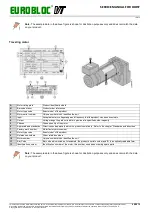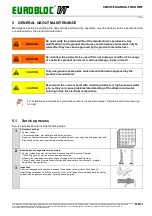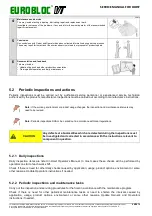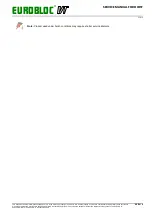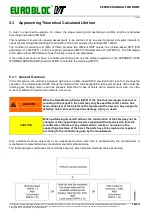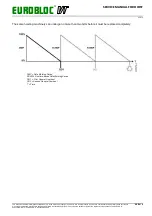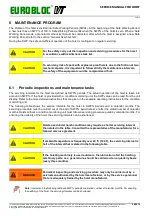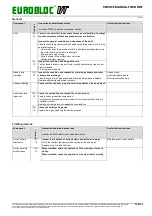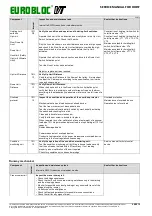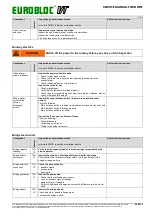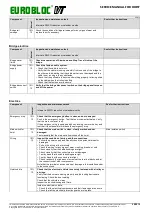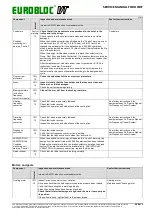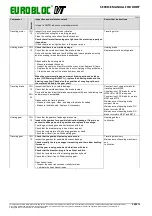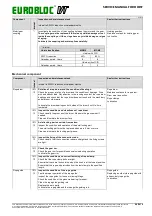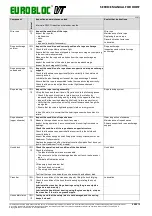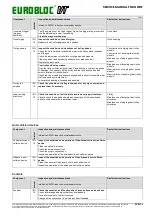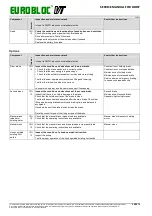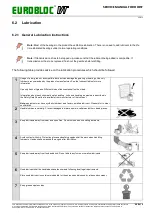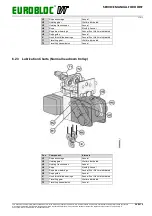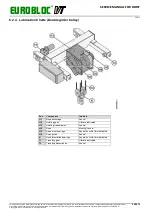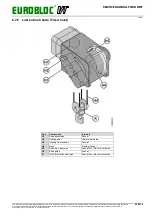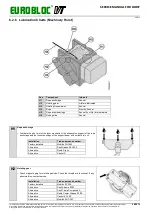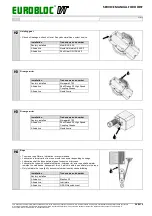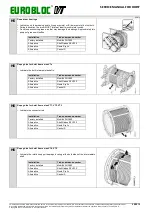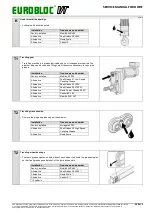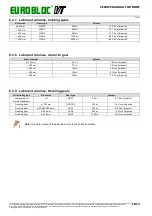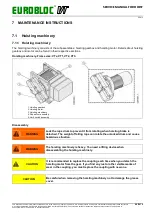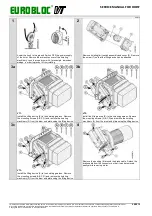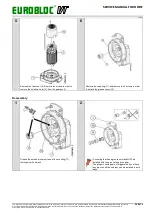
EUROBLOC
SERVICE MANUAL FOR HOIST
32/212
This document and the information contained herein, is the exclusive property of Verlinde S.A.S. and represents a non-public, confidential and proprietary trade secret that
may not be reproduced, disclosed to third parties, altered or otherwise employed in any manner whatsoever without the express written consent of Verlinde S.A.S.
Copyright © (2013) Verlinde S.A.S. All rights reserved.
06/2015
Component
In
te
rv
a
l
Inspection and maintenance task
Interval is SWP% reduction or calendar months
See further instructions
Wire rope
10%
12
Inspect the condition of the rope.
Inspect the rope for
• broken wires
• kinks
• wear
• dryness (lubricate if necessary).
Wire rope
Maintenance of wire rope
Replacing the wire rope
Discard criteria of wire rope
Lubrication
Rope anchorage
on drum
10%
12
Inspect the condition and correct position of a rope anchorage.
Check that the rope clamp nuts are tight.
Ensure that the rope has not slipped in the rope anchorage by comparing
to the nominal measurements.
Make sure that the rope end protrudes from the rope anchorage as
specified.
Inspect the condition of the wire rope near the rope anchorage.
Inspect the anchorage shaft locking.
Rope anchorage
Inspections and criteria for rope
anchorage
Rope anchorage
on dead end
10%
12
Inspect the condition of a rope sheave support and a rope anchorage
support.
Check that the sheave support shaft(s) are correctly in their slots and
correctly locked.
Lubricate the pivot bearing surfaces of the rope anchorage if needed.
Ensure that the rope is assembled inside the rope anchorage correctly.
Check that the wire rope clips have correct tightness and proper
orientation.
Rope reeving
10%
12
Inspect the rope reeving assembly.
Lift up the hook and lower it down. Pay attention to the following issues:
• Check if the hook block tries to rotate (remove the rotation by
reassembling the end fixing and by rotating to the opposite direction)
• Inspect that the reeving balancing tilts freely (in two rope systems)
• Verify that the rope moves smoothly over all sheaves and trough the
rope guide
• Ensure that the rope is tight and properly laid on drum grooves.
In true lift hoists, it is normal that the hoisting causes the hook block to
rotate.
Rope reeving system
Rope sheaves
(upper sheaves)
10%
12
Inspect the condition of rope sheaves.
Measure the rope sheaves to check if any wear.
Inspect during operation if any unusual sound is coming from sheave
bearings.
Check the condition of the rope sheave support structure.
Check that the sheave support shafts are correctly in their slots and
correctly locked.
Inspect the sheave support shaft fixing plate for any cracks (some Low
Headroom Trolley models).
Replace the support shaft by the latest construction/parts if not done yet
(some Low Headroom Trolley models).
Wear inspection of sheaves
Maintenance of rope sheaves
Sheave support and rope anchorage
support
Hook block
10%
12
Check the operation and condition of the hook block.
Check the following:
• The labels/stickers exist and are readable
• The covers are not bent or damaged and do not touch to sheaves or
rope
• Lubricate all lubrication points.
•
Lift an empty hook and test that:
• The hook does not rotate.
• The empty hook does not tilt.
•
Test that the rope runs smoothly on sheaves with and without load.
Hook block
Cross bar
10%
12
Check the condition of the cross bar hinge by tilting the hook forging.
Check the condition of the hook thrust bearing by rotating the hook
forging.
Lubricate the cross bar hinge bearings using the grease nipples
(hinged cross bars only).
Lubricate the hook thrust bearing using the grease nipple, or open
the cross bar if there is no grease nipple.
Lubrication
Hook safety latch
10%
12
Test by hand that the safety latch is not damaged and the spring
keeps it closed.

